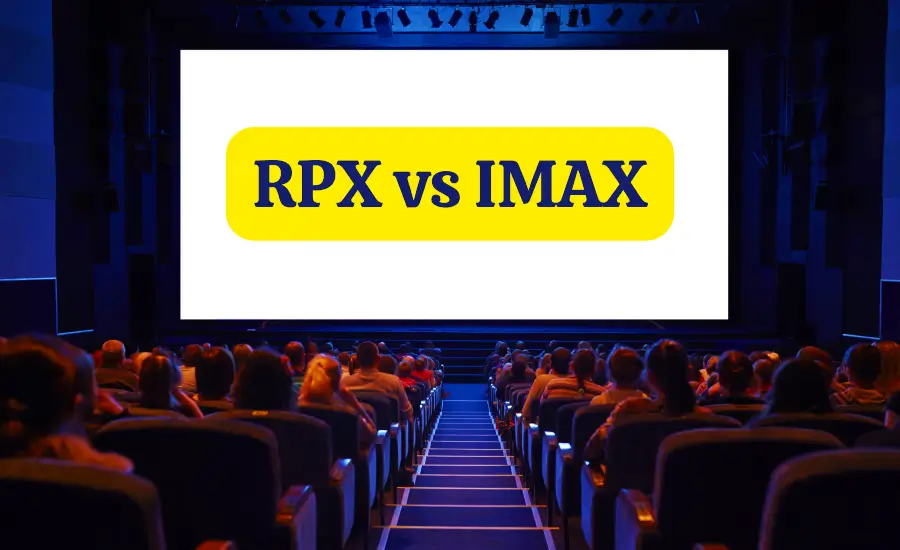IMAX is a name that has become synonymous with large-format cinema experiences. IMAX theaters are known for their massive screens, immersive audio, and state-of-the-art projection technologies that deliver an unparalleled movie-going experience.
In this article, we will delve into the world of IMAX and explore the key differences between IMAX and other formats such as XD, RPX, and standard theaters. We will also discuss the pros and cons of IMAX, its advantages over other formats, and why it continues to be a popular choice among movie enthusiasts worldwide.
Imax, short for Image Maximum, is a proprietary motion picture projection format and a theater chain known for its large screens, immersive sound, and advanced projection technology. Imax theaters are designed to provide an unparalleled cinematic experience by delivering stunning visuals and an immersive audio experience that transports viewers into the world of the movie.
Imax theaters are equipped with specialized projection equipment that offers higher resolution, brighter images, and greater contrast compared to standard movie theaters. The screens in Imax theaters are significantly larger, often spanning from floor to ceiling and wall to wall, providing an expansive field of view that fills the viewer’s peripheral vision.
Imax theaters also use a unique aspect ratio that offers a taller and wider screen, resulting in a more immersive experience with larger-than-life images that go beyond the typical movie screen. In addition, Imax theaters employ a cutting-edge sound system that includes multiple speakers placed strategically throughout the theater, providing a three-dimensional audio experience that enhances the immersion and realism of the movie.
XD vs IMAX: Understanding the Key Differences
When it comes to large-format theaters, two names that often come up are XD and IMAX. XD, short for Extreme Digital, is a brand of large-format theater technology introduced by Cinemark, one of the leading theater chains in the United States. On the other hand, IMAX is a Canadian-based company known for its pioneering work in large-format cinema.
One of the key differences between XD and IMAX is the screen size. IMAX screens are typically larger than XD screens, with some IMAX screens measuring up to 100 feet in width or more, offering a truly massive and awe-inspiring visual experience. XD screens, while still larger than standard screens, are usually smaller than IMAX screens, ranging from 65 to 75 feet in width.
Another significant difference between XD and IMAX is the aspect ratio. IMAX theaters use a unique aspect ratio that is taller and wider than the standard widescreen format used in most theaters. This aspect ratio allows for a more immersive and panoramic viewing experience. XD theaters, on the other hand, typically use the standard widescreen format.
The audio systems used in XD and IMAX theaters also differ. IMAX theaters are known for their cutting-edge audio technologies, including proprietary sound systems that deliver powerful and crystal-clear audio. XD theaters also offer advanced audio systems, but they may not match the level of sophistication and quality found in IMAX theaters.
RPX vs IMAX:

RPX, which stands for Regal Premium Experience, is a proprietary brand of Regal Entertainment Group, one of the largest movie theater chains in the United States. RPX theaters are designed to offer an enhanced movie experience with state-of-the-art technology and amenities. On the other hand, IMAX, which stands for Image Maximum, is a well-known brand that is synonymous with large-format, high-resolution movie presentations. IMAX theaters are known for their massive screens, exceptional image quality, and powerful sound systems.
One of the key differences between RPX and IMAX is the ownership and operation. RPX is owned and operated exclusively by Regal Entertainment Group, while IMAX theaters are operated by various theater chains and independent operators worldwide. Another difference is the screen size. IMAX screens are notably larger compared to RPX screens. IMAX screens can be as tall as eight stories and can span from wall to wall and floor to ceiling, creating an incredibly immersive viewing experience. In contrast, RPX screens are generally smaller in size, but still larger than regular theater screens.
The image and sound quality are also distinctive features that set RPX and IMAX apart. IMAX theaters are known for their cutting-edge projection and sound technologies, which deliver crystal-clear images and powerful surround sound that can create a truly breathtaking movie experience. IMAX theaters often use dual projection systems, which provide brighter and more vibrant images compared to RPX theaters. RPX theaters, on the other hand, offer high-quality digital projection and surround sound, but the image and sound quality may not be on par with IMAX theaters.
Another difference between RPX and IMAX is the seating arrangement. RPX theaters typically offer reserved seating, which allows moviegoers to choose their preferred seats in advance. IMAX theaters may also offer reserved seating in some locations, but it is not as common as in RPX theaters. The seating in IMAX theaters is generally more spacious, with larger, more comfortable seats and ample legroom, providing a more luxurious and comfortable movie-watching experience compared to RPX theaters.
When it comes to the types of movies shown in RPX and IMAX theaters, there is usually an overlap, with both formats showing a wide range of movies, including blockbusters, action films, and visually stunning films with high-quality graphics. However, IMAX theaters are known for their special collaborations with filmmakers and studios to release movies in an exclusive IMAX format, which may feature expanded aspect ratios or additional scenes that are specifically designed for the IMAX screen. RPX theaters, on the other hand, do not typically offer exclusive movie formats, but rather focus on providing an overall enhanced movie-watching experience.
In terms of pricing, RPX and IMAX tickets are generally priced higher than regular theater tickets due to the advanced technologies and amenities offered. However, the pricing may vary depending on the location and theater chain. RPX theaters may offer a slightly more affordable option compared to IMAX theaters
Cinemark XD vs IMAX: Which is Better?

Both Cinemark XD and IMAX offer unique and enhanced movie experiences, but which one is better? The answer largely depends on personal preferences and the specific features that matter most to you as a moviegoer.
If you value screen size and aspect ratio, IMAX may be the preferred choice. IMAX screens are generally larger and offer a more immersive aspect ratio, providing a truly awe-inspiring visual experience. The unique IMAX aspect ratio allows for a larger field of view, making you feel like you are part of the action on the screen.
On the other hand, if audio quality is a top priority for you, XD theaters may be the better option. Cinemark XD theaters are known for their advanced audio systems that deliver powerful and immersive sound. Additionally, Cinemark XD theaters are equipped with comfortable seating and offer a premium movie experience at a slightly lower price point compared to IMAX theaters.
Another factor to consider is location. IMAX theaters are located in various countries around the world and can be found in major cities and tourist destinations. Cinemark XD theaters, on the other hand, are part of the Cinemark theater chain and are primarily located in the United States. So, depending on where you are located, the availability of IMAX or XD theaters may vary.
It’s also worth mentioning that both IMAX and XD theaters often show the same movies, so the selection of films may not be a significant factor in choosing between the two. Ultimately, the best choice for you will depend on your personal preferences and priorities when it comes to the movie-going experience.
Imax Vs XD: A Comprehensive Comparison for Movie Lovers
If you’re a movie lover, chances are you’ve come across the terms “Imax” and “XD” when choosing a theater to catch the latest blockbuster. But what exactly are Imax and XD, and how do they compare to standard movie formats? In this article, we will delve into the world of Imax and XD, exploring their differences, benefits, and drawbacks, so you can make an informed decision on your next cinema experience.
Imax Vs Standard: What Sets Imax Apart?

One of the biggest differences between Imax and standard theaters is the screen size. Imax screens are significantly larger than standard screens, providing a more immersive and visually stunning experience. Imax screens are also curved, which helps to reduce image distortion and create a more uniform image across the screen.
Another key difference is the resolution. Imax projectors are capable of projecting images at a much higher resolution compared to standard theaters. Imax projectors use a proprietary technology called Imax Digital Media Remastering (DMR), which enhances the image quality by converting the movie to a higher resolution and then projecting it onto the large Imax screen. This results in sharper images with more detail and clarity, making the movie-going experience even more visually stunning.
In terms of sound, Imax theaters are equipped with a state-of-the-art sound system that provides a more immersive and realistic audio experience. Imax theaters use a proprietary sound system called Imax Immersive Sound, which includes a combination of speakers placed throughout the theater to create a three-dimensional audio experience that envelops the audience. This creates a more dynamic and realistic sound experience, enhancing the overall immersion of the movie.
Imax theaters also offer a unique aspect ratio, which provides a taller and wider screen compared to standard theaters. The unique aspect ratio of Imax screens allows for a larger field of view, making the movie feel more expansive and immersive. This aspect ratio is especially beneficial for movies that are shot in Imax format or movies that have visually stunning landscapes or action sequences.
Popular IMAX Films
Over the years, IMAX has presented an array of breathtaking films that have captivated audiences worldwide. From visually stunning nature documentaries to blockbuster Hollywood movies, IMAX has brought the magic of the big screen to life in ways that are truly unforgettable. Some popular IMAX films include “The Dark Knight,” “Interstellar,” “A Beautiful Planet,” “Blue Planet II,” and “Apollo 11.”
Conclusion
IMAX has transformed the way we experience movies, taking us on a mesmerizing journey where visuals and sound create a truly immersive cinematic experience. Its cutting-edge technology, iconic dome theaters, and commitment to delivering premium audio and visual quality have made IMAX a global leader in the entertainment industry.
Whether you’re watching an IMAX film at a theater or enjoying IMAX Enhanced content at home, you’re in for a cinematic marvel that will leave you in awe. So, go ahead and unlock the world of IMAX, and let yourself be transported to a whole new dimension of storytelling.

